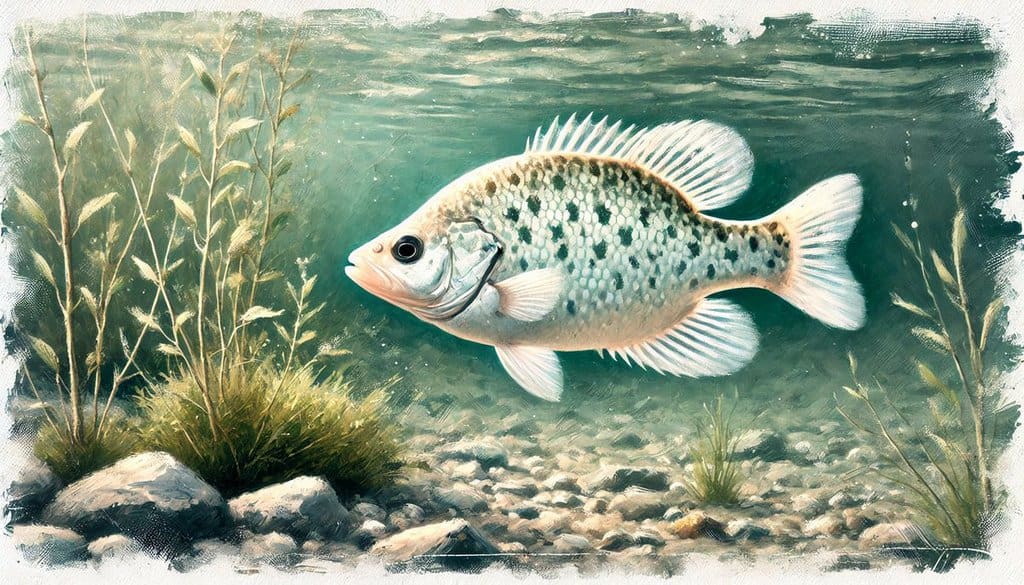White Crappie is a popular sportfish species that has gained interest in aquaponics due to its adaptability and potential for growth in controlled environments. This species is valued for its flaky, mild-flavored flesh and its ability to thrive in various water conditions. White Crappie exhibits strong growth rates and resilience, making it an attractive option for aquaponics enthusiasts looking to diversify their systems[1].
Natural Habitat and Behavior
Origin and native environment: White Crappie is native to the freshwater systems of North America, including rivers, lakes, and reservoirs. They are commonly found in the Mississippi River basin and the Great Lakes region[1].
Natural behavior in the wild: In their natural habitat, White Crappie tend to form schools and prefer areas with abundant cover, such as submerged vegetation or structures. They are known for their seasonal movements, often inhabiting deeper waters during winter months and moving to shallower areas for spawning in spring[1].
Temperament: In aquaponics systems, White Crappie generally exhibit a calm demeanor. However, they may become territorial during breeding seasons.
Compatibility: White Crappie can be kept with other species of similar size and temperament. They are often found coexisting with species like Bluegill (Lepomis macrochirus) and Black Crappie (Pomoxis nigromaculatus) in natural environments, suggesting potential compatibility in aquaponics systems[3].
Water Requirements
Temperature Range: The ideal temperature range for White Crappie is 18-25°C (64.4-77°F). Temperatures outside this range can stress the fish and affect their growth and overall health.
pH Level: White Crappie prefer slightly acidic to neutral water conditions, with a pH range of 6.5-7.5 being optimal.
Water hardness: These fish are adaptable to a range of water hardness levels but generally prefer moderately hard water.
Oxygen Levels: White Crappie require well-oxygenated water. Maintaining dissolved oxygen levels above 5 mg/L is crucial for their health and growth.
Ammonia/Nitrate Sensitivity: Like most fish, White Crappie are sensitive to ammonia and nitrite. Regular water quality monitoring and maintenance of an efficient biofilter are essential to prevent toxic buildup.
Tank or Pond Setup
Tank/Pond Size Requirements: For aquaponics, a minimum tank size of 1000 liters (264 gallons) is recommended for a small group of White Crappie. Allow approximately 40-50 liters (10-13 gallons) per adult fish.
Filtration & Aeration: Efficient filtration and strong aeration are crucial for White Crappie. They thrive in well-circulated water with ample oxygen.
Lighting Considerations: White Crappie prefer moderate lighting. Providing some shaded areas in the tank can help mimic their natural habitat and reduce stress.
Tank Decorations/Substrate: Include structures that provide hiding spots and mimic natural cover, such as plant pots, driftwood, or artificial structures. A substrate is not necessary but can be used to anchor plants.
Feeding Requirements
Diet: White Crappie are primarily carnivorous. In aquaponics systems, they can be fed a diet of commercial fish pellets supplemented with live or frozen foods like insects, small fish, and crustaceans[3].
Feeding Techniques: Feed White Crappie 2-3 times daily, offering only as much as they can consume in a few minutes. They are active feeders and will readily accept a variety of food items.
Supplements or special diets: Occasionally offering live foods can help stimulate natural feeding behaviors and provide additional nutrients.
Growth and Reproduction
Growth Rate: White Crappie exhibit moderate to fast growth rates under optimal conditions. They can reach a harvestable size of 20-25 cm (8-10 inches) within 12-18 months.
Physical Growth Indicators: As White Crappie mature, they develop a more elongated body shape and their characteristic silvery-white coloration with dark vertical bars becomes more pronounced.
Breeding Behavior: Breeding typically occurs in spring when water temperatures reach about 16-20°C (60.8-68°F). Males prepare nests in shallow areas, often near vegetation or structures.
Care of Fry: If breeding occurs, fry require specialized care including frequent feeding with micro-foods and protection from adult fish.
Harvesting & Culinary Considerations
Growth to Harvest: White Crappie are typically ready for harvest when they reach 20-25 cm (8-10 inches) in length, which can take 12-18 months in optimal conditions.
Culinary Uses: White Crappie is prized for its mild, sweet flavor and flaky texture. It is often pan-fried, baked, or grilled.
Pros and Cons in Aquaponics Systems
- White Crappie are adaptable
- Have good growth rates
- Produce high-quality flesh
- They can tolerate a range of water conditions, making them suitable for various aquaponics setups.
- They may require larger system volumes compared to some other aquaponics species.
- Their carnivorous diet might necessitate the use of protein-rich feeds, which can be more expensive.
Overall Suitability: White Crappie are best suited for intermediate to advanced aquaponics practitioners who can manage larger systems and have experience with carnivorous fish species.
Common Health Issues and Solutions
Potential Diseases: White Crappie can be susceptible to common freshwater fish diseases such as ich, fin rot, and bacterial infections.
Signs of Health Issues: Watch for symptoms like loss of appetite, abnormal swimming behavior, visible lesions, or discoloration.
Treatment Recommendations: Maintain optimal water quality and quarantine new fish before introduction. For specific diseases, consult with a fish health professional for appropriate treatments.
Maintenance Tips for Long-Term Health
Maintenance Frequency: Conduct regular water quality tests, perform partial water changes as needed, and clean filters regularly.
System checks: Monitor temperature, pH, ammonia, nitrite, and nitrate levels consistently.
Handling Practices: Minimize handling to reduce stress. When necessary, use soft nets and handle fish gently.
Winter/Summer Care: Ensure stable temperatures year-round, potentially using heaters in winter and chillers in summer if needed.
Closing Thoughts
White Crappie offer aquaponics enthusiasts an opportunity to raise a popular sportfish with excellent culinary qualities. Their adaptability and moderate growth rates make them a viable option for those looking to diversify their aquaponics systems. However, their space requirements and carnivorous diet should be carefully considered before introduction. With proper care and management, White Crappie can be a rewarding addition to an aquaponics setup.
Other fish species for aquaponics
External sources:
[1] https://www.semanticscholar.org/paper/bb4d9fec9d0a410ca4da4b0cc749015ca80e4364
[2] https://www.semanticscholar.org/paper/67f7d468b1c5cef13eb6f7990128bbcba5a3e043
[3] https://www.semanticscholar.org/paper/5393eea31fac111e3d7b8c6b2af5b79e682825c3

